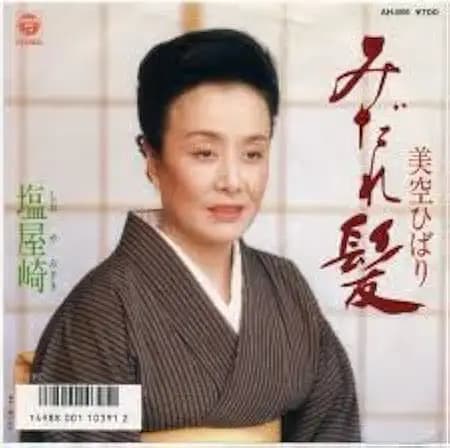曲の紹介「みだれ髪」

インフォメーション
- 曲名:みだれ髪
- アーティスト::美空ひばり
- 作詞:星野哲郎
- 作曲:船村徹【編曲】南郷達也
- レーベル:コロムビア
- リリース:
- 1987年12月10日 シングル「みだれ髪」B面「塩屋崎」
- 1988年1月1日 アルバム「みだれ髪」に収録
- サマリー:福島県いわき市平薄磯地区の塩屋埼灯台をモチーフにしており、塩屋埼には美空ふばりの記念石碑が立っている。
- 記事引用元:
- みだれ髪(美空ひばりの曲)-Wikipedia
- 美空ひばり-Wikipedia
曲について
「みだれ髪」は、昭和歌謡を代表する作詞家の星野哲郎と作曲家の船村徹の手によって作られました。
歌詞の内容は、失恋をした女性が、塩屋の岬に立ってその男性のことを想うシーンを描いています。
髪のみだれに手をやれば
赤い蹴出(けだ)しが風に舞う
憎や恋しや 塩屋の岬
投げて届かぬ
想いの糸が
胸にからんで
涙をしぼる
*引用:「みだれ髪」美空ひばりより
その他、歌詞の中で素晴らしいと思う部分を要約でご紹介しますと、
「すてたお方のしあわせを 祈る女の性(さが) かなし」
「春は二重(ふたえ)に巻いた帯 三重(みえ)に巻いても余(あま)る秋」
ほんとうに素晴らしい歌詞ですので、ぜひ原詞を一度ご覧ください。
素晴らしい星野哲郎の歌詞に、船村徹の哀しいメロディーを、歌手美空ひばりが表現力豊かに歌うと、涙を誘います。
まさしく、昭和を代表する名作の一つだと思います。
曲の動画
以下の動画をアップしています。
- みだれ髪 シングル(1989-04-21リリース)バージョン
- 不死鳥 美空ひばり in TOKYO DOME ~翔ぶ!!新しき空に向って~アルバムバージョン
アーティストの紹介「美空ひばり」
インフォメーション
- アーティスト:美空ひばり(本名:加藤和枝)
- 誕生日:1937年5月29日(1989年6月24日52歳没)
- 出身地:神奈川県横浜市磯子区
- 活動時期:1947年-1989年
- 公式サイト:
アーティストの軌跡
「美空ひばり」は、本名を加藤和枝といい、愛称は「お嬢」でした。
両親はともに歌好きで、家にはレコードがたくさんあり、幼い頃から歌謡曲や流行歌を楽しんで歌っていました。
1943年6月、父の出征を見送る壮行会で『九段の母』を歌い、その歌唱力で周囲を感動させ、これがきっかけとなり地元の横浜近郊で歌による慰問活動を始めました。
1945年、私財を投じて自前の「青空楽団」を設立し、8歳の時に「美空和枝」の名で初舞台を踏みました。
1946年にはNHK『素人のど自慢』に出場しましたが、鐘が鳴らずに不合格となりました。しかし、審査員の一人であった古賀政男に歌唱力を認められ、歌手になることを勧められました。
1947年、杉田劇場で漫談の井口静波、俗曲の音丸の前座歌手として出演し、地方巡業も行いました。
1948年2月、神戸松竹劇場への出演に際して、暴力団・三代目山口組組長の田岡一雄に気に入られ、同年5月、*ボードビリアンの川田義雄(のちの川田晴久)に横浜国際劇場公演に抜擢されました。
川田はひばりをそばに置いてかわいがり、ひばりも川田を「アニキ」と呼び慕いました。
※ボードビリアン:喜劇俳優や寄席で寸劇を演じる芸人
川田一座では、当時のスター歌手笠置シヅ子の物まね(歌まね)が非常にうまく、“ベビー笠置”と言われ拍手を浴びました。
1948年、演出家の岡田恵吉に芸名をつけてもらうこととなり、「美空ひばり」と命名されました。
※「美空ひばり」の命名者、時期については上記以外も諸説あり
国民的歌手へ
1949年1月、日劇のレビュー『ラブ・パレード』で笠置の『セコハン娘』、『東京ブギウギ』を歌い踊る子供が面白がられ、同年3月には東横映画『のど自慢狂時代』で映画初出演しました。
同年8月には松竹『踊る竜宮城』に出演し、主題歌『河童ブギウギ』でコロムビアから歌手としてレコードデビューを果たしました。
続いて12歳で映画主演を果たした『悲しき口笛』が大ヒットし、同主題歌も45万枚を売り上げ、国民的な認知度を得ました。
1950年、川田晴久とともに渡米し、帰国後すぐに『東京キッド』に主演しました。
映画とともに同名の主題歌も大ヒットし、美空ひばりは一躍国民的スターとなりました。
1952年には「リンゴ追分」が70万枚を売り上げる大ヒットとなり、当時の史上最高記録を更新しました。
三人娘
1954年、『ひばりのマドロスさん』で第5回NHK紅白歌合戦に初出場しました。
1955年には江利チエミ、雪村いづみとともに東宝映画『ジャンケン娘』に出演し、「三人娘」として人気を博しました。
結婚・離婚
1962年5月29日、小林旭との婚約を発表し、同年11月5日に挙式しました。
しかし、1964年にわずか2年あまりで離婚しました。
ソロ歌手として活躍
離婚後も、「柔」「悲しい酒」「真赤な太陽」「愛燦燦」など、数多くのヒット曲をリリースし、昭和を代表する国民的歌手として活躍しました。
1988年4月11日には、東京ドームで「不死鳥コンサート」を開催し、多くの人々を感動させました。
晩年
1987年、全国ツアー中に体調を崩し、検査入院した結果、肝炎であることが判明しました。
その後も入退院を繰り返しながらも芸能活動を続けましたが、1989年6月24日、特発性間質性肺炎の悪化により、52歳という若さで亡くなりました。
死後、その功績が認められ、国民栄誉賞を受賞しました。
彼女の歌唱スタイルや表現力は、多くの後進のアーティストに影響を与え、今なお多くの歌手によって尊敬されています。
ディスコグラフィ
代表シングル
- 悲しき口笛 (1949年)
- 東京キッド (1950年)
- リンゴ追分 (1952年)
- お祭りマンボ (1952年)
- 港町十三番地 (1957年)
- 柔 (1964年)
- 悲しい酒 (1966年)
- 真赤な太陽 (1967年)
- 愛燦燦 (1986年)
- みだれ髪 (1987年)
- 川の流れのように (1989年)
代表アルバム
- 美空ひばり全曲集 (多数のベスト盤が存在します)
- 不死鳥 (1988年、東京ドームコンサートのライブ盤)
- HIBARI SINGS JAZZ (1958年)
- 歌は我が命 (1978年)
- 美空ひばり ベスト・コレクション (1990年)
- 美空ひばり スーパーベスト (2000年)
- 美空ひばり トリビュート (2012年)
- 美空ひばり 究極のベスト (2019年)
